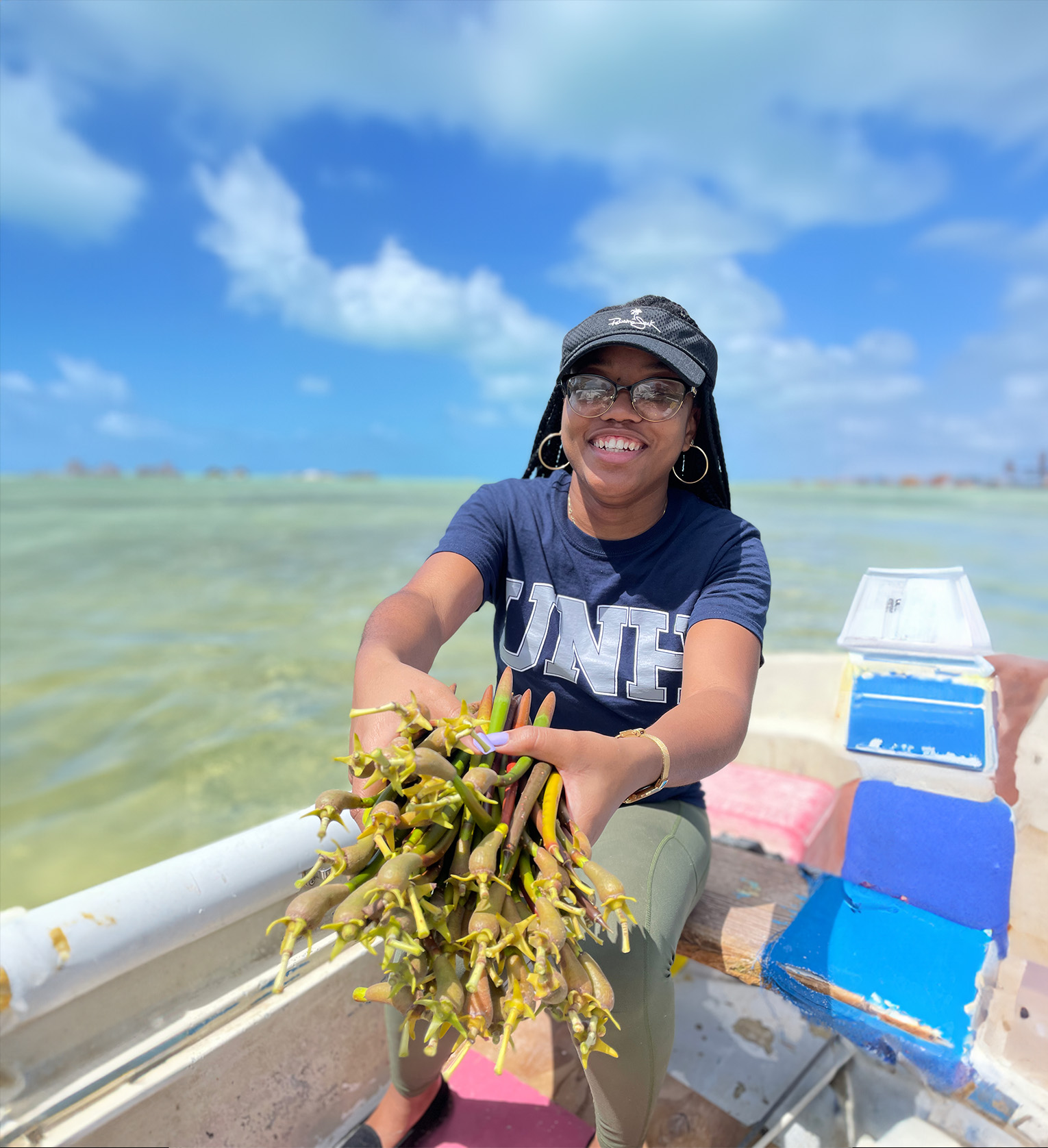
5 minute read
Caribbean Partnership EXPANDS
UNH marine and terrestrial acousticians join the teaching, research and outreach effort in the British Virgin Islands
COLSA’s teaching and research partnership with the H. Lavity Stoutt Community College (HLSCC) in Tortola, British Virgin Islands (BVI), which was spearheaded by Gregg Moore, coastal restoration ecologist and associate professor in the department of biological sciences, has expanded to include associated ecological restoration work by Michelle Fournet and Laura Kloepper, both assistant professors in the same department.
Fournet and Kloepper also support the work of two of Moore’s students, Creightanya Brewley ’24G and Nia Jeffers ’24G, HLSCC alumni who joined UNH’s graduate programs in fall 2021. Jeffers, who managed the HLSCC mangrove nursery, is comparing techniques to increase mangrove restoration planting success. Brewley has been conducting research to update the status of an endangered endemic frog known as the Virgin Islands coqui (Eleutherodactylus schwartzi) and studying the characteristics of its habitats. She hopes this work will inform conservation and management plans to protect the frogs from current and future threats.
With Fournet and Kloepper on board, the work is expanding to include acoustic studies that can help the researchers make decisions about restoration and conservation. Fournet and Moore are monitoring the soundscape of the waters around mangrove roots to detect key sea floor organisms that will help them distinguish between damaged systems, recovering systems and healthy natural systems. Kloepper, a terrestrial acoustician, is providing critical guidance in the analysis and interpretation of coqui frog recordings that Brewley is collecting in collaboration with Susan Zaluski, head of marine and maritime studies at HLSCC’s Centre for Applied Marine Studies, and Cassander Titley-O’Neal, director of the BVI’s National Parks Trust.
In addition, Kim Babbitt ’84, wildlife ecologist and COLSA’s associate dean of academic affairs, has been sharing her expertise on the community ecology of amphibians, and Bonnie Brown, professor and chair of the department of biological sciences, is leading a genomic analysis of frog DNA that seeks to corroborate acoustic data with positive identification of vocally similar taxa.
“The bioacoustic expertise Laura and Michelle are bringing to our collaborations in the BVI is creating exciting new opportunities for restoration ecology, marine biology and conservation biology,” says Moore. “I’m grateful to be able to engage with such innovative and inspiring colleagues and bring their knowledge to bear on this important work.”
The partnership is supporting a research exchange in the areas of coastal habitat restoration, coastal resilience and climate change, as well as student activities at the graduate and undergraduate levels on both the UNH and HLSCC campuses. It began in late 2017, when Moore got involved in the BVI’s efforts to assess post-hurricane mangrove recovery following the devastation caused by back-to-back hurricanes Irma and Maria.
SPOTLIGHT: NIA JEFFERS ’ 24G
Nia Jeffers (left page) is completing the last semester of her UNH marine biology master’s degree in Tortola, British Virgin Islands, where she has been hired by H. Lavity Stoutt Community College’s Centre for Applied Marine Studies to develop a curriculum to educate fifth-, sixth- and ninth-grade students about coastal resilience and marine biodiversity and teach them how to care for mangrove seedlings. It is part of a larger project funded by the European Union’s RESEMBID Fund that will affect at least four islands in the territory.
COLSA: How would you explain your discipline and/or research to a non-scientist?
Jeffers: My research focus is mangrove habitat restoration and management with a focus on red mangrove restoration methods being used in the Virgin Islands.

COLSA: Why is your research important?
Jeffers: With every mangrove that we plant and every child who is impacted by our programs, we bring our community closer to achieving a more sustainable future. Mangroves are ecologically and culturally significant habitats that protect the Virgin Islands from the impacts of storms and erosion and help to sustain the fisheries industry. My research will inform policy for restoration and management in the coming years.
COLSA: What do you plan to do with your degree?
Jeffers: I plan to develop educational programs that will encourage youth in my community to pursue careers in STEM. I am committed to ensuring that young people have the tools they need to protect our islands for generations to come.
COLSA: How does it feel to be able to do this work in the place you’re from, where you grew up, where your family is?
Jeffers: I will try to answer without getting too emotional. In 2017, I chose to take a semester off to spend time with my family. Then the hurricanes [Irma and Maria] hit. We didn’t have electricity for six months. Military personnel who arrived compared the situation to a war zone. You can still see reminders of what we lost and what we still stand to lose if we don’t ensure that we have natural ways of mitigating the effects of climate change. My work is not just about restoring mangroves — it’s about protecting my family and my community and doing whatever we can to make sure we’re better prepared in the future.










